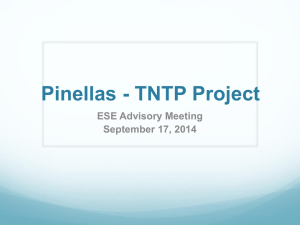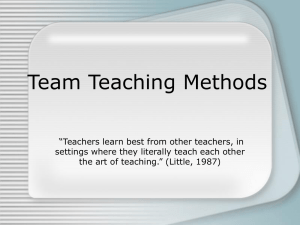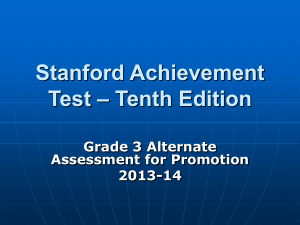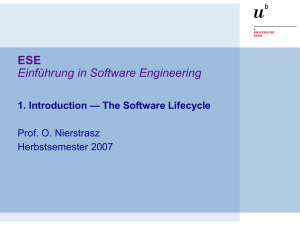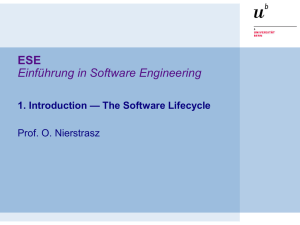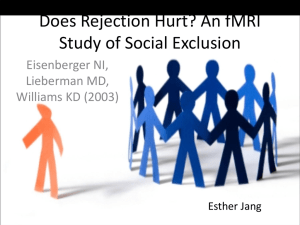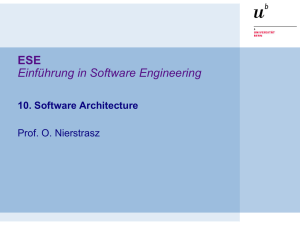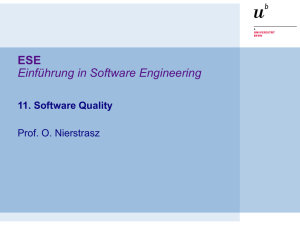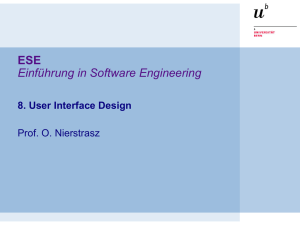01Intro
advertisement
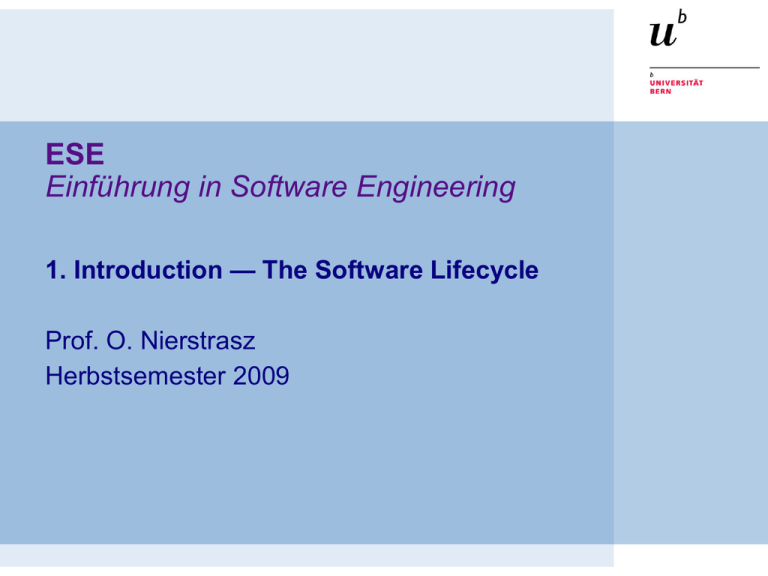
ESE Einführung in Software Engineering 1. Introduction — The Software Lifecycle Prof. O. Nierstrasz Herbstsemester 2009 ESE — Introduction ESE — Introduction Lecturer Assistants Prof. Oscar Nierstrasz scg.unibe.ch/oscar Lukas Renggli Camillo Bruni, Patrik Rauber Lectures IWI 001, Wednesdays @ 13h15-15h00 Exercises IWI 001, Wednesdays @ 15h00-16h00 WWW scg.unibe.ch/teaching/ese Selected material courtesy of Prof. Serge Demeyer, U. Antwerp © Oscar Nierstrasz ESE 1.2 ESE — Introduction Roadmap > > > > > Course Overview What is Software Engineering? The Iterative Development Lifecycle Software Development Activities Methods and Methodologies © Oscar Nierstrasz ESE 1.3 ESE — Introduction Roadmap > > > > > Course Overview What is Software Engineering? The Iterative Development Lifecycle Software Development Activities Methods and Methodologies © Oscar Nierstrasz ESE 1.4 ESE — Introduction Principle Texts > Software Engineering. Ian Sommerville. Addison-Wesley Pub Co; ISBN: 020139815X, 7th edition, 2004 > Software Engineering: A Practioner's Approach. Roger S. Pressman. McGraw Hill Text; ISBN: 0072496681; 5th edition, 2001 > Using UML: Software Engineering with Objects and Components. Perdita Stevens and Rob J. Pooley. Addison-Wesley Pub Co; ISBN: 0201648601; 1st edition, 1999 > Designing Object-Oriented Software. Rebecca WirfsBrock and Brian Wilkerson and Lauren Wiener. Prentice Hall PTR; ISBN: 0136298257; 1990 © Oscar Nierstrasz ESE 1.5 ESE — Introduction Recommended Literature > > > > > > > eXtreme Programming Explained: Embrace Change. Kent Beck. AddisonWesley Pub Co; ISBN: 0201616416; 1st edition (October 5, 1999) The CRC Card Book. David Bellin and Susan Suchman Simone. AddisonWesley Pub Co; ISBN: 0201895358; 1st edition (June 4, 1997) The Mythical Man-Month: Essays on Software Engineering. Frederick P. Brooks. Addison-Wesley Pub Co; ISBN: 0201835959; 2nd edition (August 2, 1995) Agile Software Development. Alistair Cockburn. Addison-Wesley Pub Co; ISBN: 0201699699; 1st edition (December 15, 2001) Peopleware: Productive Projects and Teams. Tom Demarco and Timothy R. Lister. Dorset House; ISBN: 0932633439; 2nd edition (February 1, 1999) Succeeding with Objects: Decision Frameworks for Project Management. Adele Goldberg and Kenneth S. Rubin. Addison-Wesley Pub Co; ISBN: 0201628783; 1st edition (May 1995) A Discipline for Software Engineering. Watts S. Humphrey. Addison-Wesley Pub Co; ISBN: 0201546108; 1st edition (December 31, 1994) © Oscar Nierstrasz ESE 1.6 ESE — Introduction Course schedule Week 1 2 3 4 5 6 7 8 9 10 11 12 13 14 © Oscar Nierstrasz Date 16-Sep-09 23-Sep-09 30-Sep-09 07-Oct-09 14-Oct-09 21-Oct-09 28-Oct-09 04-Nov-09 11-Nov-09 18-Nov-09 25-Nov-09 02-Dec-09 09-Dec-09 16-Dec-09 Lesson Introduction — The Software Lifecycle Requirements Collection The Planning Game Responsibility-Driven Design Software Validation Modeling Objects and Classes Modeling Behaviour User Interface Design Project Management Software Architecture Software Quality Software Metrics TBA Final Exam ESE 1.7 ESE — Introduction Roadmap > > > > > Course Overview What is Software Engineering? The Iterative Development Lifecycle Software Development Activities Methods and Methodologies © Oscar Nierstrasz ESE 1.8 ESE — Introduction Why Software Engineering? A naive view: Problem Specification But ... coding Final Program — Where did the specification come from? — How do you know the specification corresponds to the user’s needs? — How did you decide how to structure your program? — How do you know the program actually meets the specification? — How do you know your program will always work correctly? — What do you do if the users’ needs change? — How do you divide tasks up if you have more than a one-person team? © Oscar Nierstrasz ESE 1.9 ESE — Introduction What is Software Engineering? (I) Some Definitions and Issues “state of the art of developing quality software on time and within budget” > Trade-off between perfection and physical constraints — SE has to deal with real-world issues > State of the art! — Community decides on “best practice” + life-long education © Oscar Nierstrasz ESE 1.10 ESE — Introduction What is Software Engineering? (II) “multi-person construction of multi-version software” — Parnas > Team-work — Scale issue (“program well” is not enough) + Communication Issue > Successful software systems must evolve or perish — Change is the norm, not the exception © Oscar Nierstrasz ESE 1.11 ESE — Introduction What is Software Engineering? (III) “software engineering is different from other engineering disciplines” — Sommerville > Not constrained by physical laws — limit = human mind > It is constrained by political forces — balancing stake-holders © Oscar Nierstrasz ESE 1.12 ESE — Introduction Roadmap > > > > > Course Overview What is Software Engineering? The Iterative Development Lifecycle Software Development Activities Methods and Methodologies © Oscar Nierstrasz ESE 1.13 ESE — Introduction Software Development Activities Requirements Collection Establish customer’s needs Analysis Model and specify the requirements (“what”) Design Model and specify a solution (“how”) Implementation Construct a solution in software Testing Validate the solution against the requirements Maintenance Repair defects and adapt the solution to new requirements NB: these are ongoing activities, not sequential phases! © Oscar Nierstrasz ESE 1.14 ESE — Introduction The Classical Software Lifecycle The classical software lifecycle models the software development as a step-by-step “waterfall” between the various development phases. Requirements Collection Analysis Design Implementation Testing Maintenance The waterfall model is unrealistic for many reasons: • requirements must be frozen too early in the life-cycle • requirements are validated too late © Oscar Nierstrasz ESE 1.15 ESE — Introduction Problems with the Waterfall Lifecycle 1. “Real projects rarely follow the sequential flow that the model proposes. Iteration always occurs and creates problems in the application of the paradigm” 2. “It is often difficult for the customer to state all requirements explicitly. The classic life cycle requires this and has difficulty accommodating the natural uncertainty that exists at the beginning of many projects.” 3. “The customer must have patience. A working version of the program(s) will not be available until late in the project timespan. A major blunder, if undetected until the working program is reviewed, can be disastrous.” — Pressman, SE, p. 26 © Oscar Nierstrasz ESE 1.16 ESE — Introduction Iterative Development In practice, development is always iterative, and all activities progress in parallel. Requirements Collection Maintenance through iteration Testing based on requirements Testing Analysis Testing throughout implementation Validation through prototyping Implementation Design © Oscar Nierstrasz Design through refactoring If the waterfall model is pure fiction, why is it still the dominant software process? ESE 1.17 ESE — Introduction Iterative Development Plan to iterate your analysis, design and implementation. — You won’t get it right the first time, so integrate, validate and test as frequently as possible. “You should use iterative development only on projects that you want to succeed.” — Martin Fowler, UML Distilled © Oscar Nierstrasz ESE 1.18 ESE — Introduction Incremental Development Plan to incrementally develop (i.e., prototype) the system. — If possible, always have a running version of the system, even if most functionality is yet to be implemented. — Integrate new functionality as soon as possible. — Validate incremental versions against user requirements. © Oscar Nierstrasz ESE 1.19 ESE — Introduction The Unified Process Inception Elaboration Construction Transition Requirements Analysis Design Implementation Test Iter. #1 Iter. #2 ... ... ... ... ... ... Iter. Iter. #n-1 #n How do you plan the number of iterations? How do you decide on completion? © Oscar Nierstrasz ESE 1.20 ESE — Introduction Boehm’s Spiral Lifecycle Planning = determination of objectives, alternatives and constraints initial requirements Risk Analysis = Analysis of alternatives and identification/ resolution of risks Risk = something that will delay project or increase its cost go, no-go decision completion first prototype alpha demo Customer Evaluation = Assessment of the results of engineering © Oscar Nierstrasz evolving system Engineering = Development of the next level product ESE 1.21 ESE — Introduction Roadmap > > > > > Course Overview What is Software Engineering? The Iterative Development Lifecycle Software Development Activities Methods and Methodologies © Oscar Nierstrasz ESE 1.22 ESE — Introduction Requirements Collection User requirements are often expressed informally: — features — usage scenarios Although requirements may be documented in written form, they may be incomplete, ambiguous, or even incorrect. © Oscar Nierstrasz ESE 1.23 ESE — Introduction Changing requirements Requirements will change! — inadequately captured or expressed in the first place — user and business needs may change during the project Validation is needed throughout the software lifecycle, not only when the “final system” is delivered! — build constant feedback into your project plan — plan for change — early prototyping [e.g., UI] can help clarify requirements © Oscar Nierstrasz ESE 1.24 ESE — Introduction Requirements Analysis and Specification Analysis is the process of specifying what a system will do. — The intention is to provide a clear understanding of what the system is about and what its underlying concepts are. The result of analysis is a specification document. Does the requirements specification correspond to the users’ actual needs? © Oscar Nierstrasz ESE 1.25 ESE — Introduction Object-Oriented Analysis An object-oriented analysis results in models of the system which describe: > classes of objects that exist in the system — responsibilities of those classes > relationships between those classes > use cases and scenarios describing — operations that can be performed on the system — allowable sequences of those operations © Oscar Nierstrasz ESE 1.26 ESE — Introduction Prototyping (I) A prototype is a software program developed to test, explore or validate a hypothesis, i.e. to reduce risks. An exploratory prototype, also known as a throwaway prototype, is intended to validate requirements or explore design choices. — UI prototype — validate user requirements — rapid prototype — validate functional requirements — experimental prototype — validate technical feasibility © Oscar Nierstrasz ESE 1.27 ESE — Introduction Prototyping (II) An evolutionary prototype is intended to evolve in steps into a finished product. > iteratively “grow” the application, redesigning and refactoring along the way First do it, then do it right, then do it fast. © Oscar Nierstrasz ESE 1.28 ESE — Introduction Design Design is the process of specifying how the specified system behaviour will be realized from software components. The results are architecture and detailed design documents. Object-oriented design delivers models that describe: — how system operations are implemented by interacting objects — how classes refer to one another and how they are related by inheritance — attributes and operations associated to classes Design is an iterative process, proceeding in parallel with implementation! © Oscar Nierstrasz ESE 1.29 ESE — Introduction Conway’s Law — “Organizations that design systems are constrained to produce designs that are copies of the communication structures of these organizations” © Oscar Nierstrasz ESE 1.30 ESE — Introduction Implementation and Testing Implementation is the activity of constructing a software solution to the customer’s requirements. Testing is the process of validating that the solution meets the requirements. — The result of implementation and testing is a fully documented and validated solution. © Oscar Nierstrasz ESE 1.31 ESE — Introduction Design, Implementation and Testing Design, implementation and testing are iterative activities — The implementation does not “implement the design”, but rather the design document documents the implementation! > System tests reflect the requirements specification > Testing and implementation go hand-in-hand — Ideally, test case specification precedes design and implementation © Oscar Nierstrasz ESE 1.32 ESE — Introduction Maintenance Maintenance is the process of changing a system after it has been deployed. > Corrective maintenance: identifying and repairing defects > Adaptive maintenance: adapting the existing solution to new platforms > Perfective maintenance: implementing new requirements In a spiral lifecycle, everything after the delivery and deployment of the first prototype can be considered “maintenance”! © Oscar Nierstrasz ESE 1.33 ESE — Introduction Maintenance activities “Maintenance” entails: > configuration and version management > reengineering (redesigning and refactoring) > updating all analysis, design and user documentation Repeatable, automated tests enable evolution and refactoring © Oscar Nierstrasz ESE 1.34 ESE — Introduction Maintenance costs “Maintenance” typically accounts for 70% of software costs! Changes in Data Formats 17% Changes in User Requirement s Emergency Fixes 12% Means: most project costs concern continued development after deployment © Oscar Nierstrasz Routine Debugging 9% Hardware Changes 6% Documentation 6% Other 3% Efficiency Improvements 4% – Lientz 1979 ESE 1.35 ESE — Introduction Roadmap > > > > > Course Overview What is Software Engineering? The Iterative Development Lifecycle Software Development Activities Methods and Methodologies © Oscar Nierstrasz ESE 1.36 ESE — Introduction Methods and Methodologies Principle = general statement describing desirable properties Method = general guidelines governing some activity Technique = more technical and mechanical than method Methodology = package of methods and techniques packaged Tools Methodologies Methods and Techniques Principle — Ghezzi et al. 1991 © Oscar Nierstrasz ESE 1.37 ESE — Introduction Object-Oriented Methods: a brief history First generation: — Adaptation of existing notations (ER diagrams, state diagrams ...): Booch, OMT, Shlaer and Mellor, ... — Specialized design techniques: – CRC cards; responsibility-driven design; design by contract Second generation: — Fusion: Booch + OMT + CRC + formal methods Third generation: — Unified Modeling Language: – uniform notation: Booch + OMT + Use Cases + ... – various UML-based methods (e.g. Catalysis) © Oscar Nierstrasz ESE 1.38 ESE — Introduction What you should know! > > > > > > How does Software Engineering differ from programming? Why is the “waterfall” model unrealistic? What is the difference between analysis and design? Why plan to iterate? Why develop incrementally? Why is programming only a small part of the cost of a “real” software project? What are the key advantages and disadvantages of object-oriented methods? © Oscar Nierstrasz ESE 1.39 ESE — Introduction Can you answer these questions? > > > > > > What is the appeal of the “waterfall” model? Why do requirements change? How can you validate that an analysis model captures users’ real needs? When does analysis stop and design start? When can implementation start? What are good examples of Conway’s Law in action? © Oscar Nierstrasz ESE 1.40 ESE — Introduction License > http://creativecommons.org/licenses/by-sa/3.0/ Attribution-ShareAlike 3.0 Unported You are free: to Share — to copy, distribute and transmit the work to Remix — to adapt the work Under the following conditions: Attribution. You must attribute the work in the manner specified by the author or licensor (but not in any way that suggests that they endorse you or your use of the work). Share Alike. If you alter, transform, or build upon this work, you may distribute the resulting work only under the same, similar or a compatible license. For any reuse or distribution, you must make clear to others the license terms of this work. The best way to do this is with a link to this web page. Any of the above conditions can be waived if you get permission from the copyright holder. Nothing in this license impairs or restricts the author's moral rights. © Oscar Nierstrasz ESE 1.41
